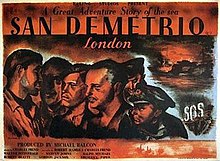This is a list of the naval forces from the United Kingdom that took part in the Falklands War, often referred to as "the Task Force" in the context of the war. For a list of naval forces from Argentina, see Argentine naval forces in the Falklands War.

Admiral Scheer was a Deutschland-class heavy cruiser which served with the Kriegsmarine (Navy) of Nazi Germany during World War II. The vessel was named after Admiral Reinhard Scheer, German commander in the Battle of Jutland. She was laid down at the Reichsmarinewerft shipyard in Wilhelmshaven in June 1931 and completed by November 1934. Originally classified as an armored ship by the Reichsmarine, in February 1940 the Germans reclassified the remaining two ships of this class as heavy cruisers.
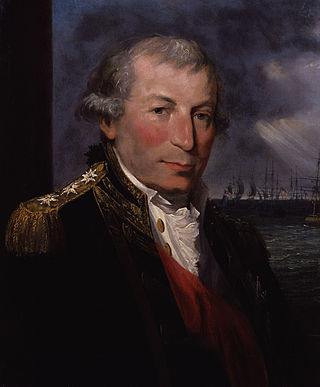
Admiral of the Fleet John Jervis, 1st Earl of St Vincent was an admiral in the Royal Navy and Member of Parliament in the United Kingdom. Jervis served throughout the latter half of the 18th century and into the 19th, and was an active commander during the Seven Years' War, American War of Independence, French Revolutionary War and the Napoleonic Wars. He is best known for his victory at the 1797 Battle of Cape Saint Vincent, from which he earned his titles, and as a patron of Horatio Nelson. Despite having a fierce reputation for discipline, his crews had great affection for him, calling him Old Jarvie.
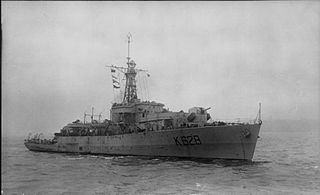
HMS Loch Killisport (K628/F628) was a Loch-class frigate of the British Royal Navy, named after Loch Killisport in Scotland. Launched in 1944, the ship was not commissioned until July 1945, and served in post-war repatriation operations in the Far East until decommissioned in April 1946. During this time Prince Philip was an officer on board this ship. Recommissioned in 1950 she served in the Home Fleet for two years, before being extensively modernised for service in the Persian Gulf and Far East. Decommissioned in August 1965, she was sold for scrapping in 1970.

HX convoys were transatlantic convoys in the North Atlantic during the First World War and in the Battle of the Atlantic in the Second World War. HX convoys sailed eastwards from Halifax, Nova Scotia in Canada, to Liverpool and other ports in Britain. They were joined the BHX convoys from Bermuda en route. After the United States entered the war, HX convoys began at New York.

Sir Michael Elias Balcon was an English film producer known for his leadership of Ealing Studios in West London from 1938 to 1955. Under his direction, the studio became one of the most important British film studios of the day. In an industry short of Hollywood-style moguls, Balcon emerged as a key figure, and an obdurately British one too, in his benevolent, somewhat headmasterly approach to the running of a creative organization. He is known for his leadership, and his guidance of young Alfred Hitchcock.

HMS Jervis Bay was a British liner later converted into an armed merchant cruiser, pennant F40. She was launched in 1922, and sunk in battle on 5 November 1940 by the German heavy cruiser Admiral Scheer in an action which earned her captain the Victoria Cross.

Captain Edward Stephen Fogarty Fegen, was a Royal Navy officer and a recipient of the Victoria Cross, the highest award for gallantry in the face of the enemy that can be awarded to British and Commonwealth forces.

SS Ohio was an oil tanker built for The Texas Company. The ship was launched on 20 April 1940 at the Sun Shipbuilding & Drydock Co. in Chester, Pennsylvania. The United Kingdom requisitioned it to re-supply the island fortress of Malta during the Second World War.
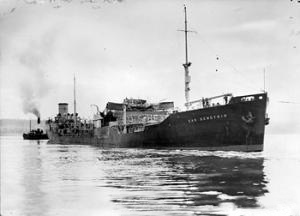
MV San Demetrio was a British motor tanker, notable for her service during the Second World War. She was built in 1938 for the Eagle Oil and Shipping Company. In 1940 she was damaged by enemy action in mid-Atlantic, abandoned by her crew but later re-boarded and successfully brought into harbour. She was the subject of a 1943 feature film, San Demetrio London, one of the few films that recognised the heroism of the UK Merchant Navy crews during the War.

HMS York was the lead ship of her class of two heavy cruisers built for the Royal Navy in the late 1920s. She mostly served on the North America and West Indies Station before World War II. Early in the war the ship escorted convoys in the Atlantic and participated in the Norwegian Campaign in 1940. York was transferred to the Mediterranean theatre in late 1940 where she escorted convoys and the larger ships of the Mediterranean Fleet. She was wrecked in an attack by Italian explosive motorboats of the 10th Flotilla MAS at Suda Bay, Crete, in March 1941. The ship's wreck was salvaged in 1952 and subsequently scrapped.
Convoy HX 84 was the 84th of the numbered series of Allied North Atlantic HX convoys of merchant ships from Halifax, Nova Scotia, and Bermuda to Liverpool, England, during the Battle of the Atlantic. Thirty-eight ships escorted by the armed merchant cruiser HMS Jervis Bay departed from Halifax on 28 October 1940, eastbound to Liverpool.
Charles Herbert Frend was an English film director and editor, best known for his films produced at Ealing Studios. He began directing in the early 1940s and is known for such films as Scott of the Antarctic (1948) and The Cruel Sea (1953).

Walter Fitzgerald Bond was an English character actor.
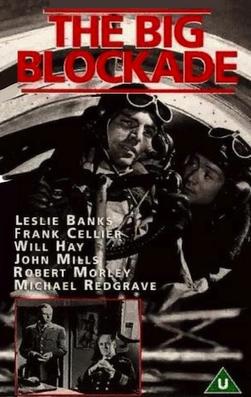
The Big Blockade is a 1942 British black-and-white war propaganda film in the style of dramatised documentary. It is directed by Charles Frend and stars Will Hay, Leslie Banks, Michael Redgrave and John Mills. It was produced by Michael Balcon for Ealing Studios, in collaboration with the Ministry of Economic Warfare.

Sir Charles Henry Knowles, 2nd Baronet, GCB was an officer of the Royal Navy, who saw service during the American War of Independence, and the French Revolutionary and Napoleonic Wars, eventually rising to the rank of Admiral. He was an extraordinary figure and a great tactical innovator. Highly intellectual, he authored a number of signal books and had the chance to put his ideas into practice during his naval career. Knowles was at times beset by problems with discipline aboard his ships, often due to large proportions of raw recruits and untrained seamen. This may have been a factor in his rocky relationship with his superior, Sir John Jervis, which eventually led to Knowles's retirement from active service after the Battle of Cape St Vincent, and his concentration on scholarly studies of the issues affecting the naval service.
SS British Consul was a tanker built by Sir James Laing & Sons Ltd., Sunderland in 1924 and operated by the British Tanker Company.

Charles Victor was a British actor who appeared in many film and television roles between 1931 and 1965. He was born Charles Victor Harvey.

SS Beaverford was a cargo liner registered in the United Kingdom and operated by the Canadian Pacific Steamship Company. She was built in 1928 for service between Montreal and London.
